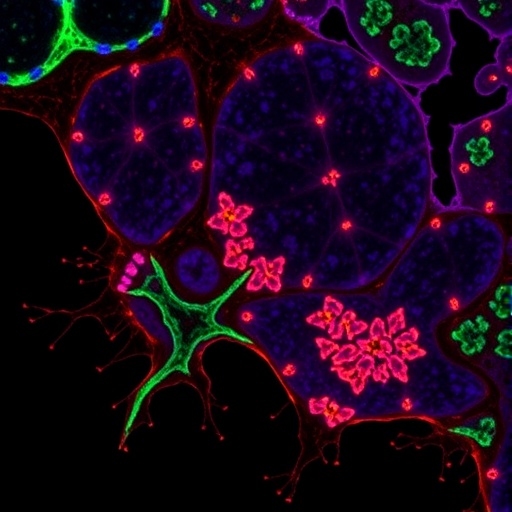In a significant breakthrough in cancer research, scientists have uncovered a fascinating link between kaempferol, a natural flavonoid found in various fruits and vegetables, and the progression of Ewing sarcoma, a highly aggressive bone cancer primarily affecting children and young adults. This discovery opens new avenues for potential therapeutic strategies aimed at combating this malignancy. Ewing sarcoma is notorious for its rapid proliferation and metastasis, making effective treatments a pressing concern for oncologists worldwide. Given the limitations of current therapies, understanding the biochemical pathways involved in tumor progression is essential for developing more targeted treatments.
The study, conducted by an innovative team of researchers including Ji, Gao, and Xu, delved into the complex interactions between kaempferol and microRNA (miR-26b-5p). MicroRNAs are small non-coding RNA molecules that play pivotal roles in regulating gene expression. Disturbances in the function of these molecules have been implicated in the pathogenesis of various cancers, including Ewing sarcoma. Through their rigorous investigations, the researchers demonstrated that kaempferol exerts a regulatory effect on the progression of Ewing sarcoma by modulating the expression of miR-26b-5p.
At the core of the study is the revelation that kaempferol enhances the levels of miR-26b-5p, leading to the downregulation of a target gene known as Family with Sequence Similarity 98 Member A (FAM98A). FAM98A has been previously associated with promoting tumor growth and invasion in various cancer types. By inhibiting the expression of this gene through the action of miR-26b-5p, kaempferol effectively suppresses the aggressive characteristics of Ewing sarcoma cells, thereby providing the basis for its therapeutic potential.
Molecular assays conducted throughout the study revealed that the administration of kaempferol led to a substantial reduction in cell viability in Ewing sarcoma cell lines. This finding is particularly crucial as it underscores the compound’s ability to hinder the survival and proliferation of cancerous cells. The researchers meticulously analyzed various concentrations of kaempferol and observed a dose-dependent effect, emphasizing its potential as an effective treatment option.
Moreover, the mechanistic insights shared in the study illuminate the complex interplay between dietary compounds and cancer biology. The elevation of miR-26b-5p levels following kaempferol treatment triggers a cascade of biological events contributing to reduced Ewing sarcoma aggressiveness. This pathway highlights the importance of nutrition and dietary interventions in cancer prevention and treatment, suggesting a nuanced relationship between what we consume and how our bodies respond to oncogenic threats.
Interestingly, kaempferol is abundantly available in many common foods, including leafy greens, broccoli, apples, and berries. The finding that such a simple dietary component can influence severe cancer progression is not only promising but also poses an intriguing question: could dietary modification be a feasible adjunctive therapy for patients with Ewing sarcoma? As the research community continues to explore this potential, it remains crucial for oncologists and nutritionists to collaborate on developing comprehensive management strategies that incorporate dietary considerations into traditional treatment protocols.
The implications of this study extend beyond theoretical research; they propose a tangible avenue for enhancing patient outcomes in Ewing sarcoma. With approximately 20% of children and adolescents diagnosed with this cancer experiencing metastasis at the time of diagnosis, the need for novel therapies is urgent. Kaempferol’s ability to target the molecular underpinnings of the disease represents a glimmer of hope for families grappling with the challenges of treatment.
Moreover, as further research is conducted to validate these findings, the possibility of kaempferol becoming a part of clinical practice moves closer to reality. Researchers are encouraged to explore the combined effects of kaempferol with existing chemotherapeutic agents to assess whether they can enhance treatment efficacy and reduce toxicity for patients. This synergistic approach could revolutionize the treatment landscape for Ewing sarcoma, potentially leading to better management of this challenging malignancy.
In addition to its anticancer properties, kaempferol has garnered attention for its anti-inflammatory and antioxidant effects, making it an attractive candidate for multifaceted therapeutic strategies. These attributes further substantiate the rationale for considering kaempferol not only in the context of Ewing sarcoma but also in a broader range of oncological and non-oncological applications. The safety profile associated with kaempferol also supports its exploration as a complementary therapeutic agent, particularly in pediatric populations where treatment options may be limited.
As researchers set their sights on validating the role of kaempferol in Ewing sarcoma, it is essential to carry out extensive preclinical and clinical trials. Through a methodical approach, these studies will provide invaluable insights into optimal dosing, potential side effects, and interactions with other medications. They will also catalyze discussions on regulatory approval processes for introducing dietary flavonoids into mainstream cancer treatment protocols.
This research underscores an exciting era in oncological studies where natural compounds could play a monumental role in shaping treatment regimens. While we await the results of ongoing trials and explore collaborations among interdisciplinary teams, the promise of kaempferol reminds us of the intrinsic links between nature and health. It prompts a re-evaluation of how we perceive cancer treatments — as multifaceted approaches that draw from both traditional pharmacology and the wisdom encapsulated in natural dietary sources.
As we look to the future, the findings of Ji, Gao, and Xu inspire a renewed focus on harnessing the power of nature in the fight against cancer. It signifies a departure from solely relying on synthetic drugs, advocating for an integrative health approach that prioritizes preventive measures and considers the profound influence of nutrition on disease dynamics. The advancement in this field heralds a hopeful transformation in cancer care that encompasses various modalities, emphasizing the essential synergy between biology, diet, and effective treatment.
Subject of Research: The role of kaempferol in regulating Ewing sarcoma progression via miR-26b-5p.
Article Title: Kaempferol regulates Ewing sarcoma progression via miR-26b-5p-mediated expression of the family with sequence similarity 98 member A.
Article References:
Ji, Y., Gao, T., Xu, Z. et al. Kaempferol regulates Ewing sarcoma progression via miR-26b-5p-mediated expression of the family with sequence similarity 98 member A. BMC Pharmacol Toxicol 26, 167 (2025). https://doi.org/10.1186/s40360-025-01008-9
Image Credits: AI Generated
DOI:
Keywords: Ewing sarcoma, kaempferol, miR-26b-5p, FAM98A, cancer therapy, flavonoids, natural compounds, dietary interventions, oncology.
Tags: aggressive bone cancer therapiesbiochemical pathways in tumor progressionEwing sarcoma progression mechanismskaempferol and Ewing sarcomamicroRNA miR-26b-5p regulationnatural flavonoids in cancer treatmentnovel cancer research breakthroughsoncological research innovationspediatric cancer therapeutic advancementsrole of microRNAs in cancertargeted treatment strategies for Ewing sarcomatumor growth modulation by kaempferol





